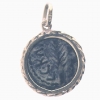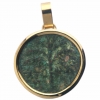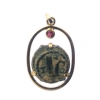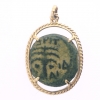|
Ancient Jewelry
|
|
 |
|
 |
|

Price :
$600.00
This stunning necklace combines man-made ornaments with the vibrant colors of natural jasper. During the Renaissance, the artisans of Venice perfected the colored glass More »
This stunning necklace combines man-made ornaments with the vibrant colors of natural jasper. During the Renaissance, the artisans of Venice perfected the colored glass techniques used by the ancients. Venetian beads were soon traded throughout the world, and were especially prized in Africa, where they assumed the stature of currency. In this remarkable jewel, the soft, earthy tones of the glass blend perfectly with the mottled richness of the stone. Such a necklace might have adorned the Queen of Sheba, Cleopatra or a tribal chief. The person who wears it today is certain to feel like royalty themselves. Circa: 1600 BC to 1800 BC Medium: Glass-Jasper « Less
|
|
Ancient Jewelry
|
|
|
|
|
| Vendor Details |
Close |
| Contact Info : |
| Barakat Gallery |
| 405 North Rodeo Drive |
| Beverly Hills |
| California-90210 |
| USA |
| Email : barakat@barakatgallery.com |
| Phone : 310.859.8408 |
|
|
|
|
|
|

Price :
$600.00
During the late Middle Ages and throughout the Renaissance, Venetian artisans rediscovered the ancient secrets of glass making. On the island of Murano, they created superb More »
During the late Middle Ages and throughout the Renaissance, Venetian artisans rediscovered the ancient secrets of glass making. On the island of Murano, they created superb vessels and jewelry which were valued throughout the known world. It was also during this period that Venice became the most powerful trading nation in Europe, a city whose ships visited every port both east and west. Venetian traders used glass beads for barter, and these jewels became especially prized in Africa, where they were traded for gold, ivory, rare woods and spices. Venetian beads quickly became a medium of exchange throughout Africa, and in some tribes were used as a bridal dowry. The rare and subtle beauty of these beads continues to dazzle the senses even after the passage of centuries. Agate, another variety of the quartz family formed in the recesses of volcanic rocks, is found in a variety of colors: red, green, blue, brown, gray and striped. Since Antiquity, agate has been one of the most popular stones for talismans and amulets, and remarkable powers are ascribed to each of the different varieties. The use of agate amulets bas continued unabated into modern times, though early examples exist from the Sumerian and Egyptian cultures, dating back four millennia before Christ. In addition to jewelry, agate was carved into cups, dishes and works of art. The Roman naturalist Pliny records that pharmacists favored mortar and pestles crafted from agate, a practice that is still common. It is a good antidote for poison, and is said to quicken the intelligence. All varieties of agate are useful for curing insomnia and inducing pleasant dreams and are thought to have a universally positive effect on those who wear them. Origin: Africa Circa: 1600 BC to 1800 BC Collection: African Medium: Glass-Agate « Less
|
|
Ancient Jewelry
|
|
|
|
|
| Vendor Details |
Close |
| Contact Info : |
| Barakat Gallery |
| 405 North Rodeo Drive |
| Beverly Hills |
| California-90210 |
| USA |
| Email : barakat@barakatgallery.com |
| Phone : 310.859.8408 |
|
|
|
|
|
|

Price :
$600.00
During the late Middle Ages and throughout the Renaissance, Venetian artisans rediscovered the ancient secrets of glass making. On the island of Murano, they created superb More »
During the late Middle Ages and throughout the Renaissance, Venetian artisans rediscovered the ancient secrets of glass making. On the island of Murano, they created superb vessels and jewelry which were valued throughout the known world. It was also during this period that Venice became the most powerful trading nation in Europe, a city whose ships visited every port both east and west. Venetian traders used glass beads for barter, and these jewels became especially prized in Africa, where they were traded for gold, ivory, rare woods and spices. Venetian beads quickly became a medium of exchange throughout Africa, and in some tribes were used as a bridal dowry. The rare and subtle beauty of these beads continues to dazzle the senses even after the passage of centuries. Origin: Africa Circa: 1600 BC to 1800 BC Collection: African Medium: Glass-Nephrite « Less
|
|
Ancient Jewelry
|
|
|
|
|
| Vendor Details |
Close |
| Contact Info : |
| Barakat Gallery |
| 405 North Rodeo Drive |
| Beverly Hills |
| California-90210 |
| USA |
| Email : barakat@barakatgallery.com |
| Phone : 310.859.8408 |
|
|
|
|
|
|

Price :
$600.00
This stunning necklace combines man-made ornaments with the vibrant colors of natural jasper. During the Renaissance, the artisans of Venice perfected the colored glass More »
This stunning necklace combines man-made ornaments with the vibrant colors of natural jasper. During the Renaissance, the artisans of Venice perfected the colored glass techniques used by the ancients. Venetian beads were soon traded throughout the world, and were especially prized in Africa, where they assumed the stature of currency. In this remarkable jewel, the soft, earthy tones of the glass blend perfectly with the mottled richness of the stone. Such a necklace might have adorned the Queen of Sheba, Cleopatra or a tribal chief. The person who wears it today is certain to feel like royalty themselves.Circa: 1600 BC to 1800 BC Medium: Glass-Jasper « Less
|
|
Ancient Jewelry
|
|
|
|
|
| Vendor Details |
Close |
| Contact Info : |
| Barakat Gallery |
| 405 North Rodeo Drive |
| Beverly Hills |
| California-90210 |
| USA |
| Email : barakat@barakatgallery.com |
| Phone : 310.859.8408 |
|
|
|
|
|
|

Price :
$320.00
Origin: Israel (Tiberias)
Circa: 52 AD to 60 AD
Collection: Jewish Coin Pendants/ Judaica
Medium: Bronze/Gold
Additional Information: This superb coin is set in an More »
Origin: Israel (Tiberias)
Circa: 52 AD to 60 AD
Collection: Jewish Coin Pendants/ Judaica
Medium: Bronze/Gold
Additional Information: This superb coin is set in an 18-karat gold pendant.
Minted under the roman administration of Israel, this bronze coin evokes a pivotal age in history. Nero, still young and popular, sat on the throne of Rome, while in a Judaea yearning for freedom; the seeds of revolt had been planted. People who had known Jesus personally were spreading the new Christian faith throughout the empire. We can never know for certain who might have held this coin then, what occupations they held or what they believed in. Yet to touch such a token of the past opens up the corridors of time and allows the imagination to travel on an endless journey of discovery. - (FJ.3700) « Less
|
|
Ancient Jewelry
|
|
|
|
|
| Vendor Details |
Close |
| Contact Info : |
| Barakat Gallery |
| 405 North Rodeo Drive |
| Beverly Hills |
| California-90210 |
| USA |
| Email : barakat@barakatgallery.com |
| Phone : 310.859.8408 |
|
|
|
|
|
|

Price :
$850.00
Origin: Israel (Caesarea)
Circa: 26 AD to 36 AD
Collection: Jewish
Medium: Bronze/Gold
Additional Information: This superb coin is set in an 18-karat gold More »
Origin: Israel (Caesarea)
Circa: 26 AD to 36 AD
Collection: Jewish
Medium: Bronze/Gold
Additional Information: This superb coin is set in an 18-karat gold pendant.
Minted by the famous Pontius Pilate, this bronze token evokes a remarkable moment in history. When the coin was first passed hand-to-hand in the towns and markets, Tiberius sat on the throne of Rome, the yearning for independence was growing in Israel, and Jesus was preaching among the people. Those who first held it might have been roman centurions, worshipers at the temple, or followers of the carpenter from Galilee. When we wear it today in it golden setting, we open up the corridors of time and set the imagination traveling on a wondrous journey of discovery. - (FJ.3759) « Less
|
|
Ancient Jewelry
|
|
|
|
|
| Vendor Details |
Close |
| Contact Info : |
| Barakat Gallery |
| 405 North Rodeo Drive |
| Beverly Hills |
| California-90210 |
| USA |
| Email : barakat@barakatgallery.com |
| Phone : 310.859.8408 |
|
|
|
|
|
|

Price :
$900.00
Origin: Israel (Jerusalem)
Circa: 132 AD to 135 AD
Collection: Jewish Coin Pendant/ Judaica
Medium: Bronze-Gold
The Judean palm tree and fertile vine leaf that adorn this More »
Origin: Israel (Jerusalem)
Circa: 132 AD to 135 AD
Collection: Jewish Coin Pendant/ Judaica
Medium: Bronze-Gold
The Judean palm tree and fertile vine leaf that adorn this ancient coin evoke the peaceful abundance that the leaders of the second revolt so fervently longed for. The representation of ideals is often expressed most poignantly through art and this coin is a sensitive example of heartfelt ideals expressed through a tangible medium. Although their dream of freedom and independence had to be deferred for centuries, it was never forgotten. This coin with its frame of gold stands as an elegant symbol of timeless ideals and ongoing faith. Sixty-two years after the destruction of the Second Temple, the second major war against the Romans broke out-- the Bar Kokhba revolt. Carefully and secretly prepared, this war was prompted by Hadrian's wish to instill Greco-Roman culture with still greater force, by prohibiting circumcision and erecting a temple to Jupiter Capitolinus on the Temple Mount. The spiritual leader of the revolt was Rabbi Akiva, while the military and civil leader was Simeon Bar Koseva (Shimon Bar Kokhba). This war was much more fierce than the first Jewish revolt, and the Romans were initially bard pressed. The Twenty-second Legion was defeated and completely wiped out and Hadrian, in his report to the Senate at the end of the war, omitted the customary mention of his own health and of the army's well being. The exact extent of the territory controlled by Bar Kokhba is not quite clear, but he certainly held the Hebron district, part of Idumea and the Dead Sea region (where the last of his fighters took shelter in desert caves). It is not known for certain if he indeed took Jerusalem, if only for a short time. The last major stand was at Bethar, and the war came to an end following Bar Kokhba's death there. From his coins, and from the documents found in the Judean desert, it is known that Bar Kokhba styled himself "Nasi (Prince) of Israel". The coins of this revolt constitute the last ancient Jewish coinage and it is quite remarkable that in that hour of bitter struggle and dire peril, the Jews took pains to mint the most pleasing series of coins ever issued in that country. Bar Kokhba had learned from the Romans how to utilize coinage as a means of mass propaganda; hence the nationalistic motifs and slogans that appear on the coins. - (FJ.5026) « Less
|
|
Ancient Jewelry
|
|
|
|
|
| Vendor Details |
Close |
| Contact Info : |
| Barakat Gallery |
| 405 North Rodeo Drive |
| Beverly Hills |
| California-90210 |
| USA |
| Email : barakat@barakatgallery.com |
| Phone : 310.859.8408 |
|
|
|
|
|
|

Price :
$620.00
Origin: Israel
Circa: 4 BC to 6 AD
Collection: Jewish Coin Pendant/ Judaica
Medium: Bronze-Ruby-Gold
Herod Archelaus was the son of Herod the Great. When his father died More »
Origin: Israel
Circa: 4 BC to 6 AD
Collection: Jewish Coin Pendant/ Judaica
Medium: Bronze-Ruby-Gold
Herod Archelaus was the son of Herod the Great. When his father died in 4 B.C., the kingdom was divided, with Herod Archelaus receiving the major and most important share of the territory, encompassing Samaria, Judea and Idumea. He w as granted the title of ethnarch, earlier conferred on john Hyrcanus II by Julius Caesar. Archelaus ruled over an increasingly hostile population, and after ten years of his reign, a Jewish delegation went to Rome and complained to Augustus about Archelaus' oppressive regime. Augustus exploited the opportunity to make further inroads into Judea, banishing Archelaus and replacing him in 6 A.D. with a Roman procurator, Coponius. Archelaus' territories were annexed to the province of Syria, with a special internal status. Archelaus used his family name--Herod- -on his coins, and it is only because of the associated title ethnarch that they can be identified as his rather than his father's. He also refrained from upsetting the Jews by avoiding emblems offensive to their religious feelings. Most of his motifs are subjects such as the galley, prow and anchor. However, there are other patterns such as the cornucopia, wreath, helmet and the bunch of grapes, similar to the golden bunch present in the temple in his father's day. This stunning coin features the depiction of the prow of a ship, facing right, with an inscription. On the reverse side is another inscription, this one surrounded by a wreath and framed by a border of dots. To wear this handsome coin, with its radiant gold and jewel setting, is to be enriched by the spirited energy of the fast that lingers within the coin, capturing us forever in its magic spell. - (FJ.5194) « Less
|
|
Ancient Jewelry
|
|
|
|
|
| Vendor Details |
Close |
| Contact Info : |
| Barakat Gallery |
| 405 North Rodeo Drive |
| Beverly Hills |
| California-90210 |
| USA |
| Email : barakat@barakatgallery.com |
| Phone : 310.859.8408 |
|
|
|
|
|
|

Price :
$470.00
Origin: Israel
Circa: 70 BC to 40 BC
Collection: Jewish
Medium: Bronze-Gold
With the decline in power of the ruling Seleucid dynasty of Syria in the second century B.C., More »
Origin: Israel
Circa: 70 BC to 40 BC
Collection: Jewish
Medium: Bronze-Gold
With the decline in power of the ruling Seleucid dynasty of Syria in the second century B.C., the Hasmoneans began to assert a greater political independence for the Jewish people. Upon the death of Alexander Janaeus in 76 B.C., his widow Salome Alexandra took over the reign of power. However, because a woman could not hold the office of high priest, this title was given to her son by Jannaeus, John Hyrcanus II. When Salome died in 67 B.C., a civil war broke out between Hyrcanus and his brother Aristobulus II which lasted four years, until the Roman general Pompey intervened. Pompey then conquered Jerusalem but left the powers of John Hyrcanus as high priest intact. From this time onward, the Romans took an active hand in the political affairs of Judea. One of John Hyrcanus' chief advisors was Antipater the Idumean who saw that his own son Herod was eventually installed on the throne after the death of Hyrcanus in 40 B.C. This beautiful bronze coin, minted during the reign of John Hyrcanus II, features the image of a double cornucopia adorned with ribbons and a pomegranate rising between horns. The other side of the coin displays a Hebrew inscription. Mounted in a regal gold pendant setting, this bronze coin is a radiant symbol of the ancient light of hope that has sustained the Jewish people for centuries. - (FJ.5265) « Less
|
|
Ancient Jewelry
|
|
|
|
|
| Vendor Details |
Close |
| Contact Info : |
| Barakat Gallery |
| 405 North Rodeo Drive |
| Beverly Hills |
| California-90210 |
| USA |
| Email : barakat@barakatgallery.com |
| Phone : 310.859.8408 |
|
|
|
|
|
|

Price :
$360.00
Origin: Israel (near Tiberias)
Circa: 52 AD to 60 BC
Collection: Jewish Coin Pendant
Medium: bronze/gold
Origin: Israel (near Tiberias)
Circa: 52 AD to 60 BC
Collection: Jewish Coin Pendant
Medium: bronze/gold « Less
|
|
Ancient Jewelry
|
|
|
|
|
| Vendor Details |
Close |
| Contact Info : |
| Barakat Gallery |
| 405 North Rodeo Drive |
| Beverly Hills |
| California-90210 |
| USA |
| Email : barakat@barakatgallery.com |
| Phone : 310.859.8408 |
|
|
|
|
|
|
|
|

|


